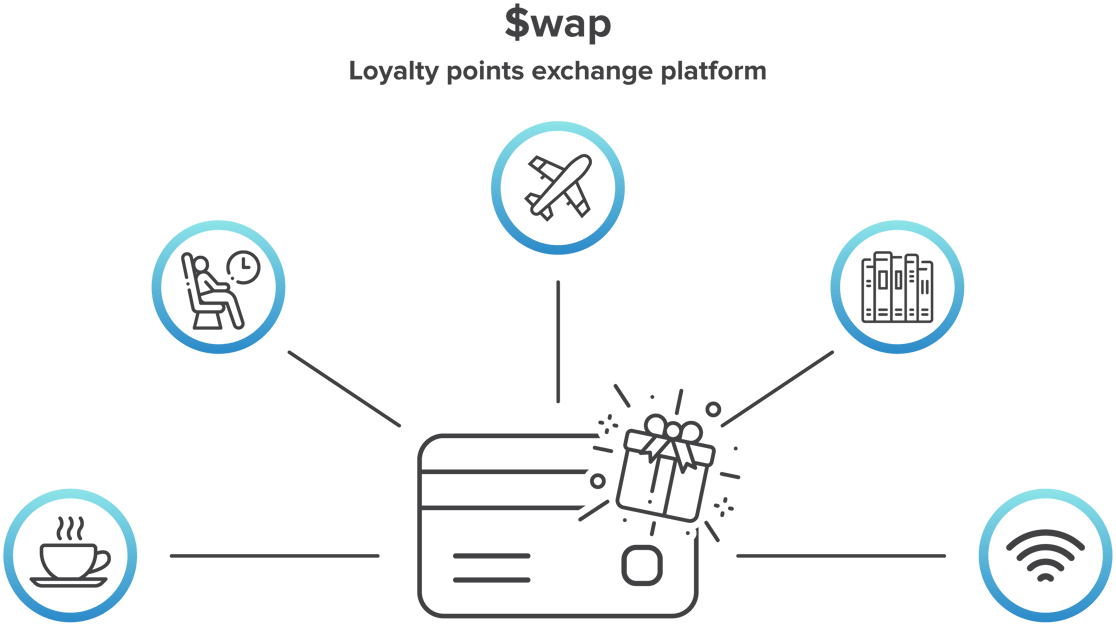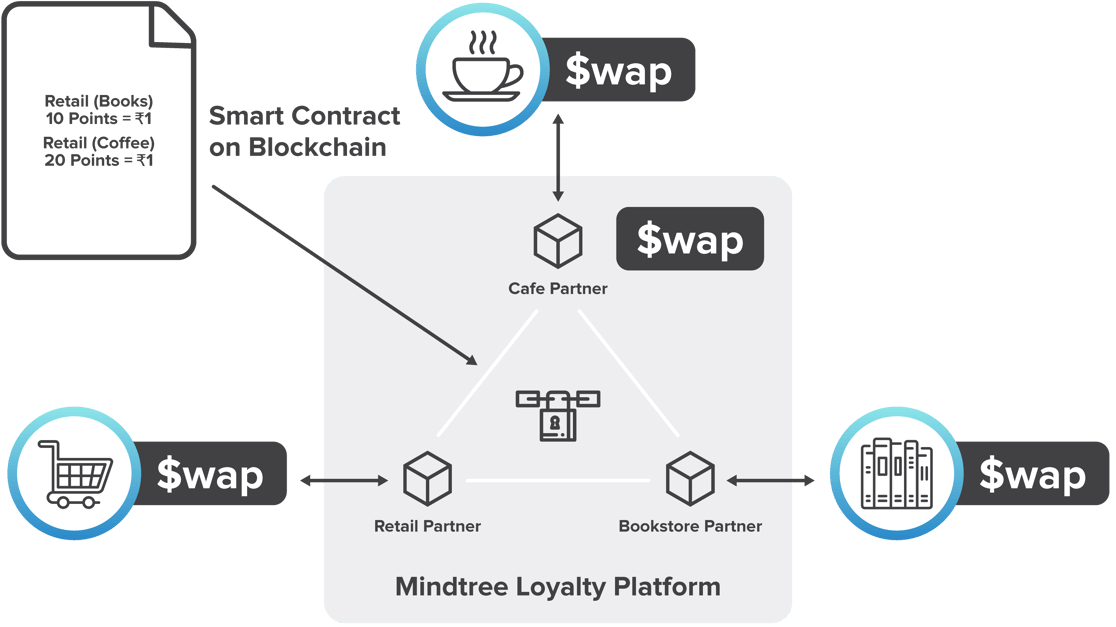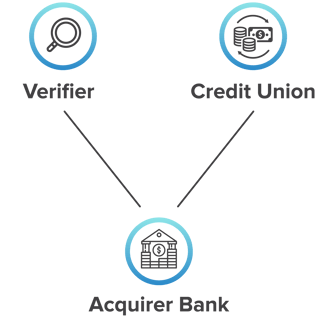How Mindtree revolutionized loyalty platforms and merchant onboarding with Hyperledger Fabric
Mindtree likes to uproot the status quo.
For more than two decades, the technology consulting and services company has helped global enterprises marry scale with agility to achieve a competitive advantage across industry verticals.
Hence, it comes as no surprise that the billion-dollar giant recently applied their digital expertise to solve institutional pain points in two different industries—the decreasing rate of redemption in loyalty programs in retail and the tedious merchant onboarding process in banking.
“Implementing a solution wasn’t the problem,” says Santanu Mukherjee, senior technical architect at Mindtree. “The challenge was to think of an innovative solution for long-standing issues that have been prevalent in these
$wap, Mindtree’s Loyalty Exchange Program
Loyalty programs have been on the rise in the retail, hotel, and airline sectors and for good reason: Consumers who adopt a rewards program (and give it a favorable review) are almost 80 percent more likely to continue spending money with the brand.
However, when customers stop participating for the perks, the impact on a brand’s bottom line is huge. Nearly $100 billion worth of points remain unused annually, which translates to missed opportunities to engage consumers and a balance sheet liability when compared to the cost of marketing and maintaining the program.
To help consumers consolidate their rewards programs and to help brands win back customers, Mindtree developed $wap, a blockchain-based loyalty exchange platform in which customers can redeem reward points across providers for goods and services.

Mindtree chose the Ionic framework to build the hybrid mobile app and deployed Hyperledger Fabric technology, which gives companies smart, contract-driven points of exchange, an easy onboarding process into the network, as well as real-time reflections of the earn and burn for loyalty points. With $wap, says Mukherjee. “all the partners who are onboarded can easily reconcile the dollar equivalent of their points systems.”
Partners in any sector—restaurants, retail brands, bookstores—can be dynamically onboarded by $wap administrators. The platform then allows merchants to negotiate exchange rates for points stored on the ledger, but these rates remain transparent only to the members who took part in the agreement. Merchants are connected using one channel with different nodes; each node represents a single organization each consisting of two peers. The endorser for each transaction is the $wap organization, which uses Raft consensus spread across different VMs for endorsing transactions.

As a result, $wap provides maximum flexibility as well as premium features to its users. Customers can pay for goods and services at any of $wap’s vendors with the ability to split up payments using points accumulated over multiple loyalty cards. (Translation: You no longer have to rack up a large number of points to start benefiting from a loyalty program.) $wap can leverage geolocation search to identify nearby vendors that accept reward points and offer intelligent suggestions for which loyalty card to redeem at member brands. The platform also allows customers to manage their various accounts and transactions as well as transfer points to friends or family members—all through one interface.
The bottom line benefits of $wap are clear. Not only can brands continue investing in loyalty programs. They can also build new revenue sharing models among onboarded partners. And if problems arise among customers, $wap allows brands to instantaneously resolve disputes or complaints since the platform’s blockchain technology provides complete traceability of all transactions.
“$wap offers the ability to constantly engage with customers increasing brand stickiness while enabling opportunities to incentivize, upsell and cross sell.”
Merchant Onboarding Platform
Merchant onboarding today is a highly manual process that involves lots of different players yet very little visibility into the procedures. Some of the issues are:
- The process can take more than 20 days.
- Businesses such as restaurants and e-commerce sites present high risks.
- There is a sizable investment in external agencies to execute third-party verifications.
- There is no standardized system to ensure vendors comply with regulations such as anti-money laundering, Know Your Customer, and Know Your Customer’s Customer.
But the biggest hurdle? “This problem is global, and yet no one wanted to create the platform to solve it,” says Mukherjee.
That is, until Mindtree revolutionized the merchant onboarding process with a new blockchain-powered platform that introduces a fast, seamless system for acquirer banks and payment service providers to engage with new businesses.
Developed on a Hyperledger Fabric channel, Mindtree uses artificial intelligence, robotic process automation, and blockchain technology to bring together all the stakeholders in the onboarding process on one platform which allows acquirer banks, verifying agencies, and prospective merchants to share documents and data in a protected, private environment. Mindtree delivers a merchant onboarding solution that is a complete onboarding and compliance management system, with underwriting and KYC as well as all contracts built into the platform. The system also allows configurable approval stages along with task management capabilities.

- Merchant onboarding time reduction from more than 20 days to one day
- Higher visibility to all parties in the transactions
- Eases merchant renewal processes
- Standardized AML & KYC processes
- Increased cost savings due to automation
Not only does adopting a unified blockchain channel create standardized and automated processes across member institutions, reducing the need for third-party verifications and cutting down operational costs. Hyperledger Fabric’s decentralized governance for smart contracts, featuring a new process for installing a chaincode among peers and starting it on a channel, allows multiple organizations to come to an agreement on the parameters of an endorsement policy.
Hyperledger Fabric also made it easier to handle the many documents involved in the merchant onboarding process by storing them externally as opposed to within the transaction data. And any data that is shared is done on a need-to-know basis thanks to the private data feature that allows organizations to keep their information regulated and protected within one channel.
As a result, most merchant applications can be processed in mere hours versus waiting for days or weeks to pass. The high degree of automation derived from AI and RPA also reduces the chances of human error and allows employees who were once bogged down with paperwork and belabored processes to reallocate their time to other responsibilities. Finally, merchant attrition rates will be less than 0.5% among renewals and first-time registrations.
“The platform enables automation of the cumbersome merchant onboarding process while providing complete visibility of the process to all parties involved.”
The future with Fabric
While each Mindtree project served a different customer, they both relied on the same solution: Hyperledger Fabric, a secure and scalable open-source distributed ledger platform developed with permissions and privacy as its core tenets.
Unlike permissionless, distributed blockchains, Hyperledger Fabric—a Hyperledger project hosted by the Linux Foundation—leverages a modular architecture that provides enterprises plug-and-play solutions for private transactions and confidential contracts.
“DLTs allow for data immutability, easy reconciliation, and data transparency—all of which were requirements in our solution systems,” says Mukherjee. “And Fabric was the private channel concept that was the best fit for both cases.”
Over the years, Hyperledger Fabric has remained Mindtree’s go-to blockchain technology. “When we started these PoCs, no other competitor was out there in the blockchain market,” says Mukherjee.
Even as more competitors have emerged as blockchain adoption becomes increasingly more prevalent, Mindtree has remained linked to Hyperledger since its early days of using Fabric v0.4. The team has since updated both $wap and the merchant onboarding system to operate on Fabric v.1.4 with Raft ordering services.
“It would have been possible to implement some of the key features with vanilla technology,” says Mukherjee. “But it would have been cost prohibitive. Open source solutions are simply easier to build.”
Now with both blockchain solutions currently in production, Mindtree is ready to introduce them to clients and innovate as needed to accommodate the demands of the marketplace. “While they may require customizations to meet specific requirements for our clients,” says Mukherjee, “we believe these platforms can be accelerators in any industry.”
About Mindtree
Mindtree [NSE: MINDTREE] is a global technology consulting and services company, helping Global 2000 corporations marry scale with agility to achieve competitive advantage. “Born digital” in 1999, more than 340 enterprise clients rely on Mindtree’s deep domain knowledge to break down silos, make sense of digital complexity and bring new initiatives to market faster. Mindtree enables IT to move at the speed of business, leveraging emerging technologies and the efficiencies of continuous delivery to spur business innovation. Operating across 17 countries, the company is consistently regarded as one of the best places to work, embodied every day by its winning culture made up of 20,000 entrepreneurial, collaborative and dedicated “Mindtree Minds.”
About Hyperledger
Hyperledger is an open source collaborative effort created to advance cross-industry blockchain technologies. It is a global collaboration including leaders in banking, finance, Internet of Things, manufacturing, supply chain, and technology. The Linux Foundation hosts Hyperledger under the foundation. To learn more, visit: www.hyperledger.org.
Sign up for Hyperledger Horizon & /dev/weekly newsletters
By signing up, you acknowledge that your information is subject to The Linux Foundation's Privacy Policy